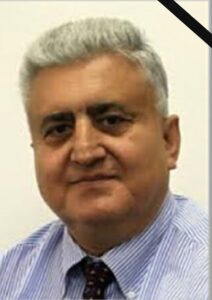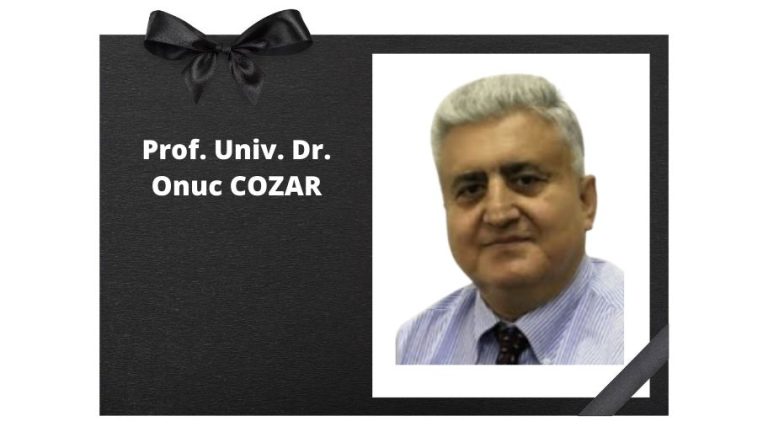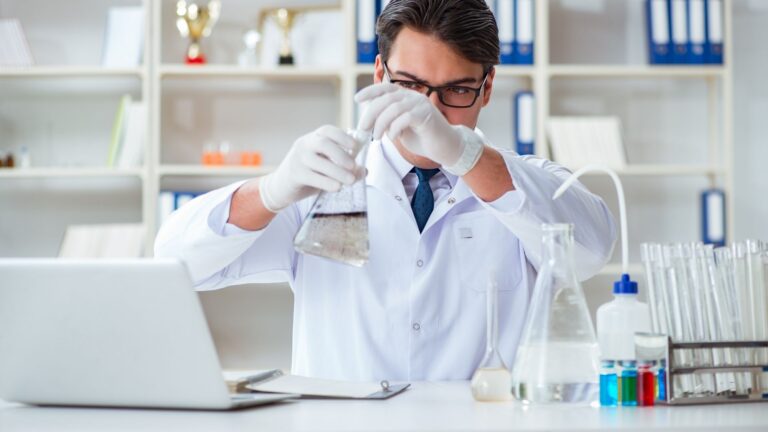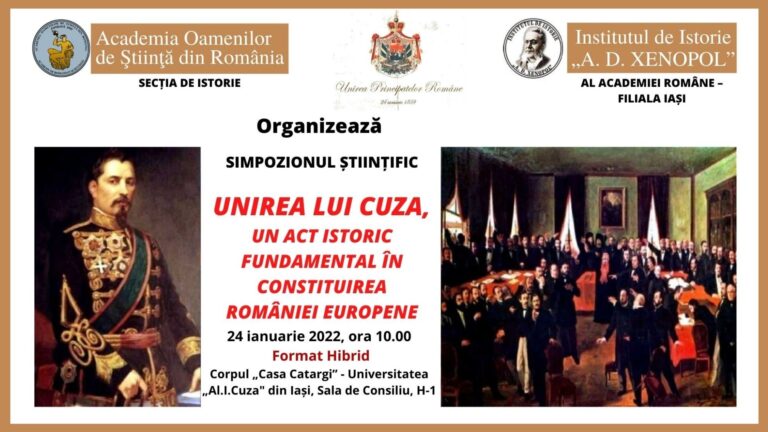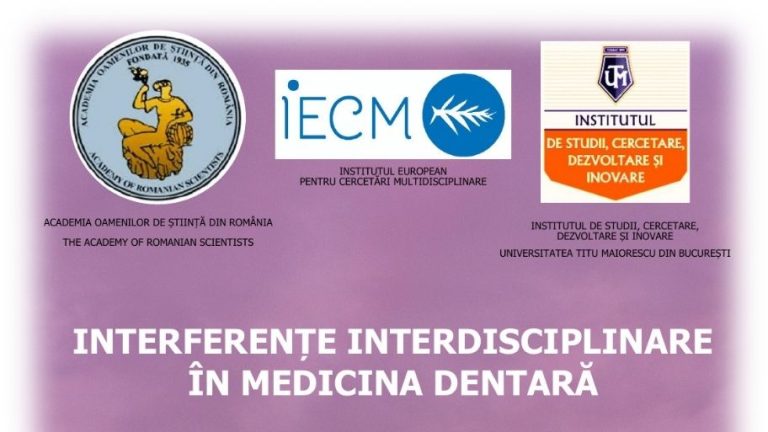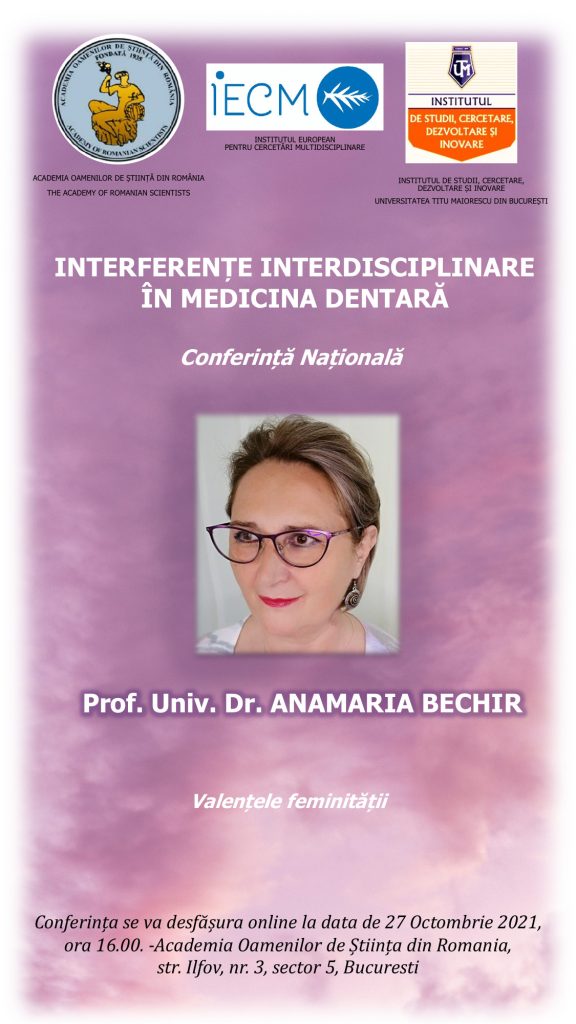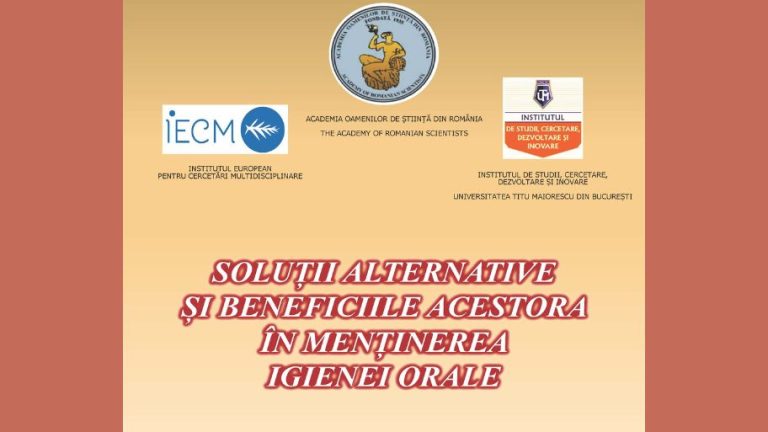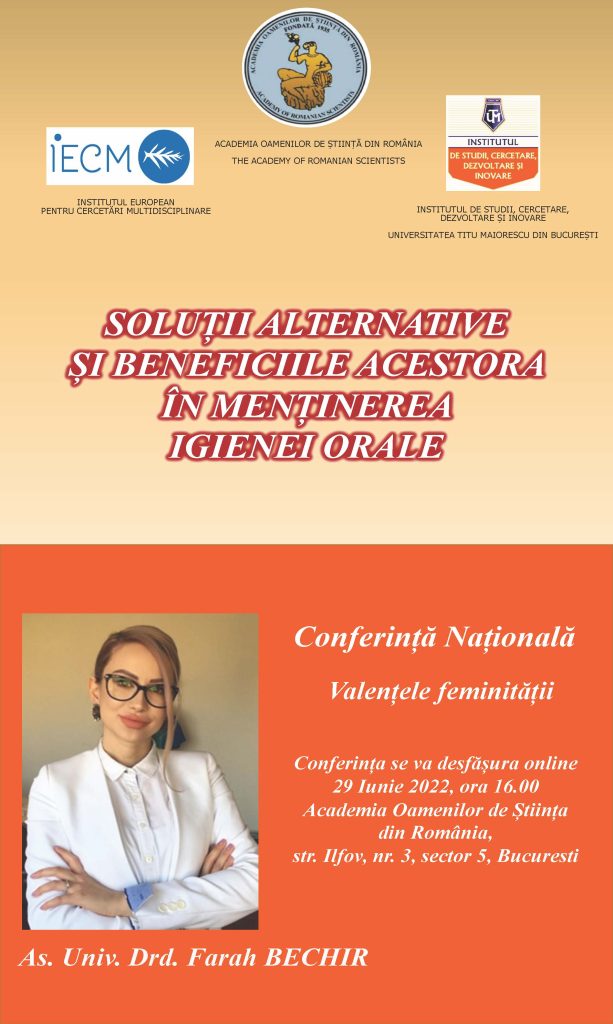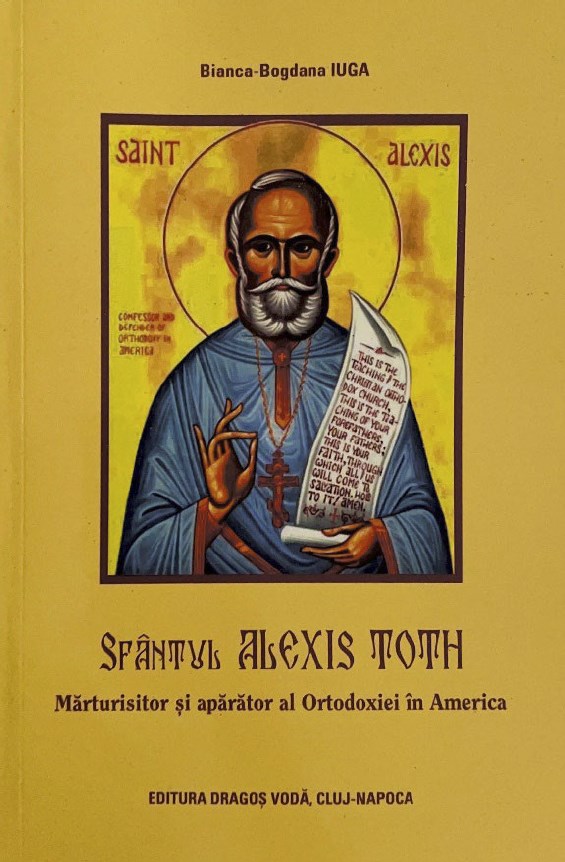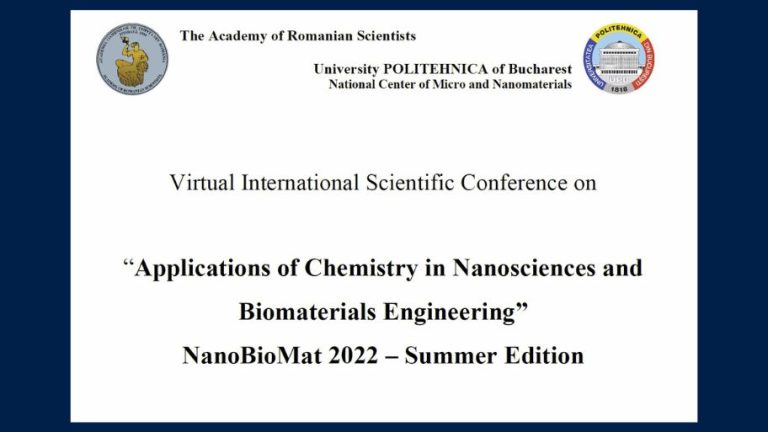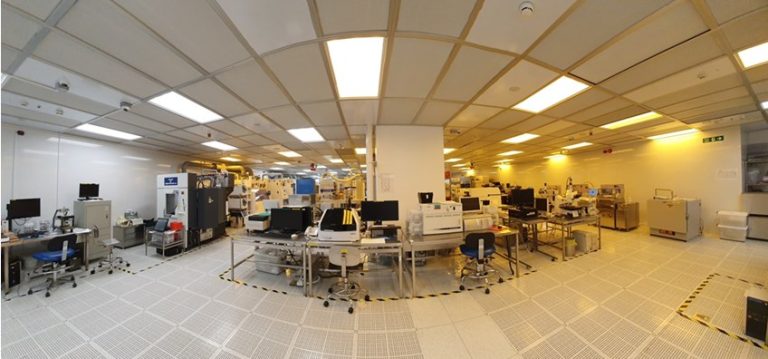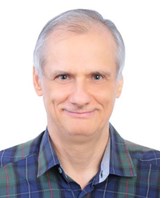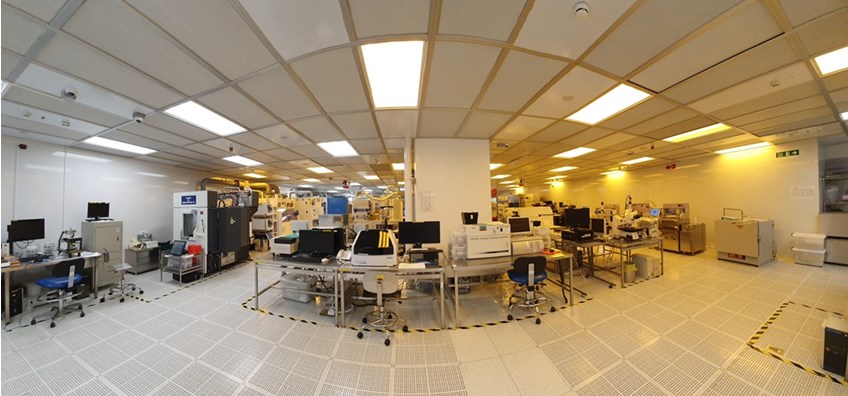The Academy of Romanian Scientists, University POLITEHNICA of Bucharest – National Center of Micro and Nanomaterials
Virtual International Scientific Conference on
“ Applications of Chemistry in Nanosciences and Biomaterials Engineering ”
NanoBioMat 2022 – Summer Edition
22-24 June 2022
Pr ogram
The program will be published on the official webpage of AOSR and UPB on 15.06.2022 as well as in the TEAMS Class. The link for the TEAMS Class is https://bit.ly/3O3ZzRJ .
The topics for the conference include, but are not limited to:
- novel materials;
- surface chemistry;
- air and soil bioremediation;
- composite materials and biomaterials;
- applications of natural compounds and chemical products;
- nanomaterials and bionanomaterials for the controlled release of biologically active molecules;
- bionanoproducts for tissue engineering and regeneration;
- advanced techniques for material processing.
D and adlines:
- Registration: 30.05.2022
- Abstract submission: 05.06.2022
- Acceptance Notification: 10.06.2022
- Final Program announcement: 15.06.2022
- Conference: 22-24.06.2022
Registration : _
Registration should be done using the link: https://bit.ly/3ztUwpy.
Registration is free for all students and postdoctoral researchers (or equivalent).
Abs tract submission:
Abstract should be submitted in MS Word document, by email, to Eng. Cristina CHIRCOV ( cristina.chircov@upb.ro ) on or before 05.06.2021. The abstract should be 150 – 300 words and it must be submitted using the template available in the registration link.
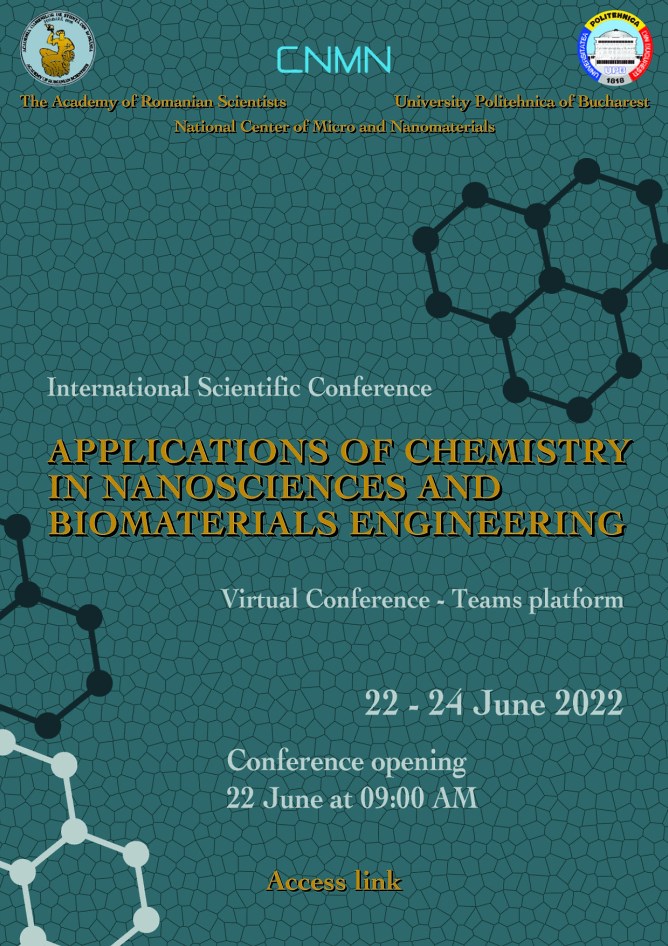
Scientific Committee _ _
Acad. Maria ZAHARESCU, Romanian Academy (Romania) Prof. Ecaterina ANDRONESCU, UPB & AOSR (Romania) Dr. Vladimir BAULIN, URV (Spain)
Prof. Aldo R. BOCCACCINI, FAU (Germany) Prof. Luigi CALABRESE, UniME (Italy)
Prof. Joan CERDÀ, UIB (Spain)
Prof. Carmen CHIFIRIUC, UniBuc (Romania) Prof. Eduard COROPCEANU, UST (Moldova)
Prof. Ioana DEMETRESCU, UPB & AOSR (Romania) Prof. Anton FICAI, UPB & AOSR (Romania)
Dr. Victor FRUTH-OPRIȘAN, ICF (Romania)
Prof. Maria GAVRILESCU, TU Iași & AOSR (Romania)
Dr. Oguzhan GUNDUZ, Marmara Univ (Turkey)
Prof. Domenico LOMBARDO, CNR-IPCF Messina (Italy) Prof. Herbert Ryan MARINI, UNIME (Italy)
Prof. Carlos MARQUES, UniStra (France) Prof. Lluis MARSAL, URV (Spain)
Dr. Viorel NACU, USMF (Moldova)
Prof. Ion NEDA, TU Braunschweig (Germany) Prof. Faik OKTAR, Marmara Univ (Turkey) Dr. Jörg OPITZ, IKTS (Germany)
Dr. Radu-Robert PITICESCU, IMNR (Romania) Prof. Lenuța PROFIRE, UMF Iasi (Romania) Prof. Serguei SAVILOV, MSU (Russia)
Prof. Ze Xiang SHEN, NTU (Singapore)
Or ganizing Committee
Prof. Ecaterina ANDRONESCU – President
Prof. Maria GAVRILESCU Prof. Anton FICAI
PhD Student, Eng. Cristina CHIRCOV – Conference Secretary
Dr. Eng. Angela SPOIALĂ – Technical Staff
PhD Student, Eng. Cornelia-Ioana ILIE – Technical Staff
Pr ogram
22 June 2022
09: 00-09: 15 – OPENING CEREMONY
Ecaterina ANDRONESCU – Chairman of the Scientific Committee
Ad ri an-Alexandru BADEA – President of The Academy of Romanian Scientists
Mihnea Cosmin COSTOIU – Rector of the Polytechnic University of Bucharest
Tudor PRISECARU – President of the Polytechnic University of Bucharest Senate
09: 15-11: 15 – PLENARY SESSION
Ch airs – Aldo BOCCACCINI, Ecaterina ANDRONESCU
09: 15-09: 45 – Bioactive Glasses Doped with Biologically Active Ions for Tissue Engineering .
Fr.of. Aldo R. BOCCACCINI
09: 45-10: 15 – Advanced Composite Materials for Low Temperature Thermochemical Energy
Storage Applications. P rof. Luigi CALABRESE
10: 15-10: 45 – Lipid Bilayers in The Bio-Nano World: Assets and Dangers .
Fr.of. Carlos MARQUES
10: 45-11: 15 – Cinchona Alkaloids and Their Derivatives as Multifunctional Chiral Ligands in A s y mm et r i c Catalysis .
Prof. Ion NEDA
11: 15-12: 30 – POSTER SESSION (I)
Ch airs – Herbert Ryan MARINI, Denisa FICAI
- Phytotoxicity of Cd (II) and Pb (II) in Single and Binary Mixture Solutions to Lavandula Angustifolia L. Seeds Germination . Laura Hagiu Zaleschi, Isabela-Maria Simion, Maria Apostol, Gabriel Ciprian Teliban, Mihai Stavarache, Adrian Nazare, Raluca-Maria Hlihor
- Biopolymer-Based Interpenetrated Hydrogels for Wastewater Treatment. Iulia Elena Neblea, Tanța-Verona Iordache, Anamaria Zaharia, Andreea Olaru, Andreea Miron, Mircea Teodorescu, Andrei Sarbu, Anita-Laura Chiriac
- Molecularly Imprinted Polymer Based Electrochemical Sensor for Ephedrine Hydrochloride D etec t i on . Sorin-Viorel Dolana, Elena-Bianca Stoica, Tanţa-Verona Iordache, Anamaria Zaharia, Anita-Laura Chiriac, Teodor Sandu, Andrei Sârbu, Ana-Mihaela Gavrilă
- Application of Heterogeneous and Homogeneous Photocatalysis in the Treatment of Wastewater Contaminated with Organo-Persistent Pesticides . Maria Dragan, Andreea Iacob, Oana Dragostin, Magdalena Bîrsan, Oana Ionescu, Ioana Vasincu, Maria Apotrosoaei, Florentina Lupascu, Alin Focşa, Alexandru Sava, Lenuţa Profire, Cătălina Stan
- The Potential of Alfalfa (Medicago Sativa L.) in Phytoremediation of Soil Contaminated with Copper Ions. I onela Cătălina Vasilachi, Petronela Cozma, Mariana Diaconu, Maria Gavrilescu
- Effects of Heavy Metals Stress on the Growth and Development of Brassica Napus (Rapeseed) at Laboratory Scale. Maria Paiu, Petronela Cozma, Ionela Cătălina Vasilachi, Mariana Minuț, Mariana Diaconu, Maria Gavrilescu
- The Synthesis of Novel Polyssaccharide Based Nanocomposite Materials. Comparative Study of Cloisite Clay Type. Raluca Ianchis, Ioana Catalina Gifu , Elvira Alexandrescu, Maria Minodora Marin, Sabina Burlacu, Catalin Mihaescu, Cristina Lavinia Nistor, Cristian Petcu
- Pulsed Laser Emission in Rhodamine B – Doped DNA Biopolymer. Adrian Petris, Ileana Rau, On the throne Gheorghe
- Anticancer Activity of Cyanobacteria. Alina Trofim , Cezara Bivol, Oleg Turcanu
- Advances in Green Synthesis of Metal Oxide Nanoparticles used in Tissue Engineering. Denisa- Maria Radulescu , Ecaterina Andronescu, Alexandru-Mihai Grumezescu, Ionela Andreea Neacsu, Adrian-Ionut Nicoara
- Current Trends in the Synthesis of Natural Hydroxyapatite-Based Materials for Tissue Engineering. Diana-Elena Radulescu , Ecaterina Andronescu, Alexandru-Mihai Grumezescu, Ionela Andreea Neacsu, Otilia Ruxandra Vasile
- Magnetite Microspheres for the Controlled Release of Rosmarinic Acid. Cristina Chircov , Diana- Cristina Pîrvulescu, Alexandra Cătălina Bîrcă, Ecaterina Andronescu
- Collagen Wound Dressings Loaded with CuO- and ZnO-based Microspheres. Alexandra Cătălina Bîrcă , Mihai Adrian Minculescu, Alexandru Mihai Grumezescu, Cristina Chircov, Ecaterina Andronescu
- Comparative Study of a Glycopeptide Antibiotic Release Behavior from Mesoporous Materials Using Different Loading Methods. Georgiana Dolete , Bogdan Purcăreanu, Anton Ficai, Dan Eduard Mihaiescu, Ovidiu Oprea, Roxana Trusca
- Application of Aerobic Granular Sludge Technology for Treating Aminoacids Compounds from Piggery Industry. Bárbara Socas Rodríguez, Ruth Rodríguez-Ramos, Adrián Conde-Díaz, Álvaro Santana-Mayor, Antonio V. Herrera-Herrera, Miguel Ángel Rodríguez-Delgado
12: 30-13: 30 – LUNCH BREAK
13:30 – 16:00 – SESSION I. ADVANCED TECHNIQUES FOR MATERIAL DESIGN AND PROCESSING
Ch airs – Jörg OPITZ, Ioana DEMETRESCU
13: 30-13: 45 – Graphene-Quantum-Dots-Decorated Nickel Aluminate Spinel Binary Nanostructure as Diagnostic Tool in Electrochemical Biosensing. Elzbieta Regulska, Joanna Breczko, Anna Basa, Beata Szydlowska, Katarzyna Kakareko, Alicja Rydzewska-Rosołowska, Tomasz Hryszko
13: 45-14: 00 – Calcium Phosphate Coatings Obtained by Radiofrequency Magnetron
Sputtering For Bone Tissue Engineering Applications. M aria E. Zarif, Sasa A. Yehia, Bogdan Biță, Andreea Groza, Alexandru Grumezescu, Ecaterina Andronescu
14: 00-14: 15 – An Electrically and Optically Tuned Surfactant Free Non-Aqueous Self- Stabilized Nematic Emulsions for Optical Device Applications. Ash ok Chaudhary , Ravi K. Shukla
14: 15-14: 30 – Water-Soluble Schiff Base and its Corresponding Palladium Complex: Synthesis, Characterization, Oral Toxicity and Anticancer Activities . Khadija Khaldoune, Ali Hasnaoui, Ali Oubella, Karima Lafhal, Larbi Elfirdoussi, Naima Fdi, Mustapha AitAli
14: 30-14: 45 – Preparation and Wetting Mechanism of Hierarchically Textured Aluminum-Based Superhydrophobic Surfaces . Amani Khaskhoussi , Luigi Calabrese, Edoardo Proverbio
14: 45-15: 00 – Thermodynamic Approach of Curcumin and Whey Protein Binding . Levete R acz, Csaba-Pal Racz, Ossi Horovitz, Aurora Mocanu, Maria Tomoaia-Cotisel
15: 00-15: 15 – 3D Printing of Ca10(PO4)6(OH)2 Abtained from Natural Sources. Maria-Eliza PUScso, Ștefania Chiriac, Miruna-Adriana Ioța, Laura-Mădălina Cursaru, Roxana Mioara Piticescu
15: 15-15: 30 – Bacterial Cellulose Use for Templating Growth of MOF Nanoparticles for O xy Gen Reduction Reaction Electrocatalytic Activities. Berna Alemdag , Aytekin Uzunoglu, Semra Unal Yildirim, Unal Sen, Mustafa Erkartal, Cem Bulent Ustundag
15: 30-15: 45 – Magnetron Sputtered Titania and Carbon Fiber Cloth Composite and its Application in Electrochemical Supercapacitors . Aleksei P.Kozlov , Ekaterina A. Arkhipova, Serguei V. Savilov
15: 45-16: 00 – Fabrication of MOS Gas Sensors . Ghazala Ansari , Vinod Kumar
13:30 – 15:45 – SESSION II. NATURAL BIOACTIVE COMPOUNDS
Chairs – Viorel NACU, Anton FICAI
13: 30-13: 45 – Determination of Total Polyphenols Content in Taraxacum Officinale Leaves. A l a Fulga, Valeriana Pantea
13: 45-14: 00 – Therapeutic Formulations Containing Plant Secondary Metabolites Used to Increase the Efficiency of Antibiotics. Cristina Teodora Dobrota, Diana Alexandra Florea, Rahela Carpa, Gheorghe Tomoaia, Aurora Mocanu, Maria Tomoaia-Cotisel
14: 00-14: 15 – Synthesis of Medicinal Plant Based Bioactive Electrospun Nanofibrous Mats and Their Effect on The Antioxidant Activity. Ayşe Betül Demirel , Serap Ayaz Seyhan, Dilek Bilgiç Alkaya, Sumeyye Cesur, Oguzhan Gunduz
14: 15-14: 30 – Characterization and Application of Silver Nanoparticles Decorated Electrospun Nanofiber Loaded with Naringenin . Ayşem Birinci , Serap Ayaz Seyhan, Dilek Bilgiç Alkaya, Sumeyye Cesur, Oguzhan Gunduz
14: 30-14: 45 – Design and Characterization of Medicinal Plant Based Nanofibers and Their Effect on The Antioxidant Activity . Tuğçenur Ekici, Elif Doğrul, Dilek Bilgiç Alkaya, Serap Ayaz Seyhan, Sumeyye Cesur, Oguzhan Gunduz
14: 45-15: 00 – Chitosan, Chitin from Marine Resources – Basic Bricks in The Obtaining of Multifunctional Materials . Oana-Maria Memecică , Cătălina Ușurelu, Ana Maria Albu, Ileana Rău
15: 00-15: 15 – Curcumin Loaded Ethyl Cellulose Microparticles on 3D Scaffolds for Diabetic Wound Healing. Melih Musa Ayran , Songul Ulag, Rıdvan Yıldırım, Oguzhan Gunduz
15: 15-15: 30 – Mesoporous Silica Materials Loaded with Gallic Acid with Antimicrobial Potential. Gabriela Petrisor, Denisa Ficai, Ludmila Motelica, Roxana Doina Trusca, Alexandra Catalina Bîrca, Bogdan Stefan Vasile, Georgeta Voicu, Ovidiu Cristian Oprea, Augustin Semenescu, Anton Ficai, Mircea Ionut Popitiu, Irina Fierascu, Radu Claudiu Fierascu, Elena Lacramioara Radu, Lilia Matei Laura Denisa Dragu, Ioana Madalina Pitica, Mihaela Economescu, Coralia Bleotu
15: 30-15: 45 – Investigation of the Potential of Whey Protein / Vitamin E Particles Coated Whey Protein / PVA Nanofibers for the Treatment of Muscle Loss . Kudret Irem Deniz , Songul Ulag, Oguzhan Gunduz
16:00 – 16:30 – BREAK
16:30 – 18:45 – SESSION III. BIOMATERIALS FOR TISSUE ENGINEERING AND REGENERATION (I)
Ch airs – Oguzhan GUNDUZ, Maria TOMOAIA-COTIȘEL
16: 30-16: 45 – Production of 3D Printed Dental Membrane Scaffold Reinforced with P omegranate Extract. H atice Karabulut , Songul Ulag, Oguzhan Gunduz
16: 45-17: 00 – Nanocomposites Based on Hydroxyapatite and Vitamins. Alexandra Avram , Aurora Mocanu, Ossi Horovitz, Gheorghe Tomoaia, Sorin Riga, Maria Tomoaia- Cotisel
17: 00-17: 15 – New Innovative Dressing with Self-Adapting and Self-Healing Properties for Chronic Wounds Treatment. Simona Tatarusanu , Florentina Lupascu, Alexandru Sava, Bianca-Stefania Profire, Andreea Iacob, Anca Rusu, Paula Stamate, Andra Manaila, Lenuta Profire
17: 15-17: 30 – Novel Bioactive Chitosan-PEO-Based Nanofibers for Wound Healing Applications: An In Vivo Study . Oana Maria Ionescu , Andreea Teodora Iacob, Francesca Floris, Alessia Farci, Teodora Hanghicel, Ioannis Gardikiotis, Irina-Draga Căruntu, Simona Giușcă, Lenuța Profire
17: 30-17: 45 – Dox Loaded PVA Tumor Dressing for Cancer Therapy . Gözde Çelik , Ahsen Yilmaz, Yağmur Şimşek, Cem Bülent Üstündağ
17: 45-18: 00 – Production and Characterization of PVA / Whey Protein / Hydroxyapatite / Gentamicin Loaded Scaffolds for Bone Tissue Engineering Applications . Tufan Arslan Tut , Sumeyye Cesur, Oguzhan Gunduz
18: 00-18: 15 – Design and Fabrication of Metformin-Loaded Tri-Layer PCL / PVA / PCL Scaffolds for Chronic Wound Healing. Sena Harmanci , Sumeyye Cesur, Oguzhan Gunduz, Cem Bulent Ustundag
18: 15-18: 30 – Biomimetic Chitosan / PEO Nanofibers as Non-Cytotoxic Wound Dressings. And again – Teodora Iacob , Oana-Maria Ionescu, Teodora Iurașcu, Maria Apotrosoaei , Florentina Lupașcu, Ioana Vasincu, Alexandru Sava, Maria Drăgan, Dan Lupașcu, Lenuța Profire
18: 30-18: 45 – Composite Coatings with Graphene Oxide for Dental and Orthopedic Implants . R adu Nartiță , Daniela Ioniță, Marius Enachescu, Ioana Demetrescu
16:30 – 19:00 – SESSION IV. ENVIRONMENTAL APPLICATIONS OF MATERIALS AND NANOMATERIALS
Ch airs – Serguei SAVILOV, Ovidiu OPREA
16: 30-16: 45 – A Sustainable Solution: Biological Treatment of Morpholine and its Derivatives (MAID) in Environment. Rup and Kumar
16: 45-17: 00 – CO 2 Capture Performance of Sulfur and Oxygen Doped Carbons Derived from a Molecular Precursor. A l i Can Zaman
17: 00-17: 15 – Sustainability Analysis of Cr (VI) Removal from Wastewaters Using Saccharomyces Cerevisiae. Cătălina Filote , Mihaela Roșca, Isabela Maria Simion, Raluca Maria Hlihor
17: 15-17: 30 – Statistical and Soft Computing Approaches for the Evaluation and Optimization of Bioremediation Processes . Mihaela Roșca , Raluca-Maria Hlihor, Petronela Cozma, Isabela-Maria Simion, Maria Gavrilescu
17: 30-17: 45 – Sampling Devices Used to Collect Indoor Airborne Viruses . Diana Mariana Cocârță, Anca Cristina Gogoncea , Mariana Prodana, Ioana Demetrescu, Constantin Streche, Adrian Alexandru Badea
17: 45-18: 00 – Nanomaterials as Efficient Sorbents for the Development of Sustainable A nalytical Methods . Ruth Rodríguez-Ramos , Adrián Conde-Díaz, Bárbara Socas-Rodríguez, Álvaro Santana-Mayor, Antonio V. Herrera-Herrera, Miguel Ángel Rodríguez-Delgado
18: 00-18: 15 – Study of Nickel, Copper and Silver Co-Doped ZnO Based Nanocrystalline DMS. Sh aveta Thakur
18: 15-18: 30 – Glass Fabrics Functionalization for the Development of High Performance Sandwich Structures. George-Valentin Săftoiu , Carolina Constantin, Adrian-Ionuț Nicoară, George Pelin, Anton Ficai
18: 30-18: 45 – Recent Advances in the Application of Nanobiotechnology for Sustainable Use of Bioresources: A Sine Qua Non for the Ever-Increasing Global Population. Charles Oluwaseun Adetunji
18: 45-19: 00 – Air and Soil Bioremedation . Gori Goyal
23 June 2022
09:00 – 11:30 – SESSION V. DRUG DELIVERY APPLICATIONS OF NANOMATERIALS AND BIOMATERIALS
Ch airs – Carlos MARQUES, Victor FRUTH-OPRIȘAN
09: 00-09: 15 – The Influence of Coordinative Compounds, Thiosemicarbaside Derivates on the Thiol-Disulfide Groups in Human Red Blood Cells . Valeriana Pantea, Evelina Lesnic, Ala Fulga
09: 15-09: 30 – Non-Pressurized Topical Spray . Neelam Pawar
09: 30-09: 45 – Antibacterial Ability of Poly Lactic Acid Microspheres Loaded with Hydroxyapatite and Vancomycin. Gertrud-Alexandra Paltinean, Sorin Rapuntean, Gheorghe Tomoaia, Sorin Riga, Aurora Mocanu, Maria Tomoaia-Cotisel
09: 45-10: 00 – Pharmaceutical Approaches of Nanobodies . Marina Ionela Ilie , Adrian Siluan Ivan, Doina Drăgănescu, Bruno Ștefan Velescu, Denisa Ioana Udeanu, Andreea Letiția Arsene
10: 00-10: 15 – Exosomes in Neuroscience as Biomaterials . Jale Odabaşı Bağcı, Şule Aydın Türkoğlu, Esra Cansever Mutlu
10: 15-10: 30 – Novel Highly Efficient Multi-Target Nanoparticles in Type 2 Diabetes Mellitus.
Fl orentina Geanina Lupașcu , Andreea Teodora Iacob, Ioana Vasincu, Maria Apotrosoaei, Georgiana Taușer, Maria Drăgan, Magdalena Bârsan, Alin Focșa, Alexandru Sava, Andra Ababei, Simona Tătărușanu, Profire Lenuța
10: 30-10: 45 – Preparation of Tretinoin Nanocrystals Loaded Gel for Improvement of Dermal Pe rm e ation and Anti-Cancer Activity . Akash Sharma, Manish Kumar
10: 45-11: 00 – Drug Designing for More Potent Drug Towards H1N1 Influenza Virus . Aakanksha Y adav
11: 00-11: 15 – Phytochemical and Pharmacological Evaluation of Myricaria Germanica from Northern Himalayan Region of India. Nissar Ahmad, Saima Shafi, WY Raja, D. Tewari, ZA Bhat
11: 15-11: 30 – Formulation of Capsaicin Nanoparticles: Potential Uses in Food, Pharmacy and Medicine Applications. M oncef Chouaibi
11: 30-12: 30 – POSTER SESSION (II)
Ch airs – Esra Cansever MUTLU, Andreea-Teodora IACOB
- The Synthesis of Novel Polyssaccharide Based Nanocomposite Materials. the Study of Inorganic Filler Concentration. Raluca Ianchis , Ioana Catalina Gifu, Elvira Alexandrescu, Maria Minodora Marin, Sabina Burlacu, Catalin Mihaescu, Cristina Lavinia Nistor, Cristian Petcu
- Novel Nanocomposites Based on Mesoporous Titania / Acrylonitrile Obtained by Host-Guest Method. Andreea Miron , Tanta-Verona Iordache, Sorin-Viorel Dolana, Marinela Dumitru, Ana-Mihaela Gavrila, Anamaria Zaharia, Horia Iovu, Anita-Laura (Radu) Chiriac
- Influence of CaCO 3 A ddition on Alkali Activated Materials. Ad ri an-Ionuț Nicoară , Adelina Carmen Ianculescu
- Molecularly Imprinted Supermacroporous Cryogels for Penicillin G Adsorption . Marinela Victoria Dumitru , Tanta-Verona Iordache, Miron Andreea, Teodor Sandu, Sorin Viorel Dolana, Horia Iovu, Andrei Sarbu, Anita-Laura (Radu) Chiriac
- MAPLE-Coatings from Bioglasses and Antibiotics for Improved Implant Surfaces. Irina Negut, Carmen Ristoscu, Tatiana Tozar, Valentina Grumezescu, Mihaela Dinu, Anca Constantina Parau, Marcela Popa, Miruna S. Stan
- Phosphatic Nanomaterials with High Performance for Organic Pollutants Adsorption. Roxana Ioana Brazdis , Sorin-Marius Avramescu, Irina Fierascu, Anda Maria Baroi, Toma Fistos, Radu Claudiu Fierascu
- Potential Antimicrobial Apatitic Materials Improved with Different Metals for Heritage Science. Toma Fistos , Roxana Ioana Brazdis, Anda Maria Baroi, Irina Fierascu, Lia-Mara Ditu, Valentin Raditoiu, Radu Claudiu Fierascu
- Innovative Drug-Delivery Scaffolds Used for Post Operatory Infections Treatment. Adrian Moraru , Ana-Maria Pușcașu, Cristina Chircov, Alexandra Cătălina Bîrcă, Adrian Surdu, Vladimir Lucian Ene, Ionela Neacșu
- Prevention and Treatment of Nosocomial Infections: A Review. Marian Rașcov , Ecaterina Andronescu, Anton Ficai, Ovidiu Cristian Oprea
- Development of New Zinc Oxide Antiseptics for the Clinical Treatment of Wounds. Irina Elena Doicin , Ionela Andreea Neacsu, Vladimir Lucian Ene, Bogdan Stefan Vasile, Ecaterina Andronescu
- Thiol-Disulfide Groups in Patients with Pulmonary Tuberculosis. Evelina Lesnic , Valeriana Pantea
- Barrier Performance of Spray Coated Nanocellulose Film . Kirubanandan Shanmugam
- Magnetic Core-Shell Nanoparticles Obtained Through Different Synthesis Methods. Dan Ad ri an Vasile , Bogdan Stefan Vasile, Anton Ficai
- Antimicrobial Activity of Cinnamaldehyde Schiff Bases . Neetu Singh
- Application of Nanomaterials in Food: Processing and Characteristics. Mohammad Zarein
12:30 – 13:30 – LUNCH BREAK
13:30 – 15:30 – SESSION VI. CONTROLLED RELEASE OF ACTIVE SUBSTANCES FOR BIOMEDICAL APPLICATIONS
Ch airs – Domenico LOMBARDO, Lenuța PROFIRE
13: 30-13: 45 – Controlled Release of Drugs from Three-Dimensional Scaffolds Containing Drug- Loaded Photocatalytic Bismuth Ferrite Nanoparticles . Sule Ilgar , Songul Ulag, Oguzhan Gunduz, Cem Bulent Ustundag, Musa Turker
13: 45-14: 00 – The Effect of Crosslinking Time on the Release of Gentamicin from Nanofibers. Esra Pilavci , Sumeyye Cesur, Elif Ilhan, Mustafa Sengor, Ewa Kijeńska-Gawrońska, Oguzhan Gunduz
14: 00-14: 15 – Release Profile of Some Cyclodextrin-Ibuprofen Derivatives Complexes – In Vivo Study. Ioana-Mirela Vasincu , Maria Apotrosoaei, Florentina Lupașcu, Andreea Iacob, Maria Drăgan, Alexandru Sava, Gabriela Dumitrița Stanciu, Anca-Roxana Petrovici, Narcisa Marangoci, Mariana Pinteală, Lenuța Profire
14: 15-14: 30 – New Nitric Oxide-Releasing Indomethacin Derivatives: Synthesis and Biological Evaluation . Alexandru Sava , Andreea Iacob, Ioana Vasincu, Florentina Lupascu, Maria Apotrosoaei, Alin Focsa, Maria Dragan, Alina Panainte, Nela Bibire, Frederic Buron, Sylvain Routier, Lenuţa Profire
14: 30-14: 45 – Nanostructured Drug Delivery Systems in Oncotherapy . Paul Adrian Tărăbuță , Anton Ficai
14: 45-15: 00 – Fluconazole and Cinnamaldehyde Loaded-Multilayer Elektrospun Nanofibers for the Treatment of Fungal Keratitis . Elif Ilhan , Sumeyye Cesur, Faik Nuzhet Oktar, Oguzhan Gunduz
15: 00-15: 15 – Graphene-Based Drug Loaded Drug Delivery System for Cancer Treatment . R e yhan Yanıkoğlu , Fatih Çiftçi, Zeynep Karavelioğlu, Rabia Çakır Koç, Cem Bülent Üstündağ
15: 15-15: 30 – Bioactive Organometallics . Irina-Gabriela Voinea
13: 30-16: 00 – SESSION VII. ADVANCED BIOMEDICAL APPLICATIONS Chairs – Luigi CALABRESE, Maria GAVRILESCU
13: 30-13: 45 – Structural Analysis of Dibenzepine and Butyrophenone Derivatives in the Context of Ventral Striatum Abnormalities in Schizophrenia. Grabukasz Grabowski
13: 45-14: 00 – Advanced Oxidation Protein Products Variation in Experimental Ovarian Torsion . C ornelia Lazăr , Olga Tagadiuc, Silvia Stratulat
14: 00-14: 15 – Bismuth Nitrate Added Polymer-Based Strain Sensors for Biomedical Applications . Mer ve Sırtıkara , Mustafa Şengör
14: 15-14: 30 – Application of Gold Nanoparticles. Rahul Kanaoujiya , Shekhar Srivastava
14: 30-14: 45 – Physicochemical Properties of Shea Butter Oil and Its Application . Maurice Jemkur, Shoge Monsurat
14: 45-15: 00 – Polymorphism Genetics Aspect; The Challenging of Personalized Medicine in Indonesia. Syahrul Tuba , Rifly Aprianto, Gilang Bhakti Nusantara, Raja Rajendra, Fatkhu Rahman
15: 00-15: 15 – Synthesis and Biomedical Application of Metal Nanoparticles . Mittal Thakkar
15: 15-15: 30 – Synthesis of Copper Nanoparticles from Origanum Species . Dhivya A. Sasikala
15: 30-15: 45 – Applications of Ceria Nanoparticles . Aasma Bibi , Humaira Razzaq
15: 45-16: 00 – Graphene as Smart Material. Abullais Nehal Ahmed
15:30 – 16:00 – BREAK
16:00 – 18:50 – SESSION VIII. MATERIALS AND NANOMATERIALS FOR ADVANCED APPLICATIONS
Ch airs – Cem Bulent USTUNDAG, Radu FIERASCU
16: 00-16: 20 – The Role of Micro- and Nanoparticles in Stratospheric Ozone Depletion. Mr. V. Savilov , Natalia E. Strokova , Natalia N. Kuznetsova
16: 20-16: 35 – Barrier Performance of Spray Coated Nanocellulose Film. Kirubanandan Sh anmugam
16: 35-16: 50 – Lipid Membrane Hydroperoxidation Favor Ion Permeability. Eulalie Lafarge , Pierre Muller, André Schroder, Jan Behrends, Ekaterina Zaitseva, Carlos Marques
16: 50-17: 05 – DLP 3D Printing of GelMA Microneedles. Dilruba Baykara , Tuba Bedir, Elif Ilhan, Cem Bulent Ustundag, Oguzhan Gunduz
17: 05-17: 20 – Indazole as an Inhibitor of Brass Corrosion in Chloride Solution 1 M HCl: Electrochemical / Surface Studies . Zakia Aribou , Nidal Khemmou, Moussa Ouakki, Sara Sibous, Rida Alah Belakhmima, Abdelaziz Souizi, Mohamed Ebn Touhami
17: 20-17: 35 – Bioinformatics Investigation of Mercury Methylating in Mycobacterium . He n r y Njoku
17: 35-17: 50 – Conversion of Zeolite- X into Various Ion Exchanged Forms and Investigation of Their Catalytic Efficiency as Green Heterogeneous Catalyst for the Synthesis of 5- Substituted 1H-Tetrazole Derivatives . Sami Ullah bhat
17: 50-18: 05 – Mechanically Robust Smart Hydrogel for Dye Removal of Pesticides. Aabid H uss i an Shalla , Riyaz Ahmad Bhat
18: 05-18: 20 – The Enhancement of the Performance of Photovoltaic Parameters of NiOx Thin Films Assisted Silicon Solar Cell through Down Shifting. Chandra Kumar , Antonio Zarate, Arturo Martinez
18: 20-18: 35 – Study of Nanocrystalin Superconductors . Sumit Kumar Gupta
18: 35-18: 50 – Air and Soil Bioremediation . Anamika Gautam
24 June 2022
09:00 – 11:00 – SESSION IX. BIOMATERIALS FOR TISSUE ENGINEERING AND REGENERATION (II)
Ch airs – Heiko FRANZ, Radu PITICESCU
09: 00-09: 15 – Fabrication of PLA / PVA / Graphene Oxide Nanofibers for Biomedical Applications. F atih Altun , Mustafa Şengör, Songul Ulag, Oguzhan Gunduz
09: 15-09: 30 – Biocompatible Coatings with Antimirobial Properties on Stainless Steel Supports . Maximum Maximov , Roxana Trusca, Anton Ficai
09: 30-09: 45 – Production of Antimicrobial Manganese Loaded Hydroxyapatite / Sodium Alginate Bone Scaffolds with Additive Manufacturing . Muge Koyun , Selin Yasar, Elif Ilhan, Nazmi Ekren, Bilal Cinici, Oguzhan Gunduz
09: 45-10: 00 – Production of 3D-printed PVA-Sodium Alginate-GelMA based Wound Dressing Scaffolds for the Treatment of Burns . Muhammet Sefa Izgordu , Songul Ulag, Oguzhan Gunduz
10: 00-10: 15 – Cerium-substituted Hydroxyapatite for Bone Regeneration. Alexandra-Cristina Burdusel , Ecaterina Andronescu, Alexandru-Mihai Grumezescu, Anton Ficai, Alina Maria Holban
10: 15-10: 30 – Morphology, Structural and Thermal Degradable Properties of Carboxylmethyl Cellulose / CuO Nanoparticles . Win Pa Pa Phyo , Yamin Thet, May Thazin Kyaw, Ngwe Sin, Aung Than Htwe
10: 30-10: 45 – Three-Dimensional Polycaprolactone Scaffold Combined with Tetracycline- Loaded Electrospray Particles . Rabia Betul Sulutas , Sumeyye Cesur, Oguzhan Gunduz
10: 45-11: 00 – Retinoids for Dermatological Applications – Cosmetic Formula with Retinol Impregnated in Bioglass – Overview of Skin Aspect Improvement on Patient with Acne. Ioana Lixandru Matei
11: 00-12: 00 – POSTER SESSION (III)
Ch airs – Vladimir BAULIN, Bogdan Stefan VASILE
- Molecularly Imprinted Surfaces Doped with Conductive Polymers for Lipopolysaccharide Recognition. Ana-Lorena Neagu, Bianca-Elena Stoica, Ana-Mihaela Gavrila, Andreea Miron, Sorin Dolana, Andrei Sarbu, Horia Iovu, Tanta-Verona Iordache
- Design and In Vitro Evaluation of New Electrospun Nanofibers Based on Chitosan / Polyvinyl Alcohol for Wound Healing. Teodora Iurașcu , Teodora A. Iacob, Alexandru Sava, Oana M. Ionescu, Lenuța Profire
- The Influence of Nanomaterials on the Grapevine Stomata. Daniela-I. Sărdărescu, Diana E. Vizitiu, Radu C. Fierăscu, Irina Fierăscu, Liliana C. Soare, Camelia Ungureanu, Elena C. Buciumeanu, Anda M. Baroi
- Chitosan / Hydroxyapatite Based Composite Structures for Bone Cancer Treatment. Alina Florentina Vladu , Ludmila Motelica, Alexandra Ene, Ecaterina Andronescu, Ionela Neacsu, Anton Ficai
- Bee Derived Products and Their Applications in Skin Tissue Engineering . Corina Dana Dumitru1 , Ionela Andreea Neacsu, Alexandru Mihai Grumezescu, Ecaterina Andronescu, Denisa Ficai
- Coordination Compounds of Cu (II) and Bi (III) with Ethylenediaminetetraacetate Ions and 2- Acetylpyridine Thiosemicarbazones . Elena Neguta, Greta Balan, Aurelian Gulea, Ion Bulimestru
- Black Phosphorus: Properties, Synthesis, and Applications . Andra-Maria Sîrmon , Ecaterina Andronescu, Ionela-Andreea Neacșu, Vasile-Adrian Surdu, Alexandru Mihai Grumezescu
- Optimization of Alginate Micro / Nanoparticles Preparation by Emulsification / Internal Gelation Method Using Box-Behnken Design . Naima Faghmous , Djallel Bouzid
- Formulation and Characterization of Topical Niosomal Gel containing Aceclofenac and Serratiopeptiasis . Rama Shukla
- Analysis of Upconversion Luminescence in Y 2 O 3 : E r , Yb Phosphors. Liviu Dudaș , Angela Enachi, Daniela Berger, Cristian Matei
- Gelatin Cryogels in Wound Healing: Properties and Synthesis. Daniela Alina Ionita , Ecaterina Andronescu, Ionela Andreea Neacsu, Vasile Adrian Surdu, Alexandru Mihai Grumezescu
- Structural, Impedance and Dielectric Behavior of Stronium Hexa Ferrites for Energy A pplications . Muhammad Salman Habib , Muhammad Asif Rafiq
- Exprimental Study of ZnO / Porous Silicon Nanocomposites Prepared by Electro Deposition T ec hnique . Naceur Selmane , Ali Cheknane
- Climate Variability Over Northwest Himalayan Region . Neha , RK Dogra, N. Kumar
- Graphene . Rahul Kanaoujiya
12:00 – 13:00 – LUNCH BREAK
13:00 – 16:00 – Fate of ESKAPE Bacteria from Hospital to Water Bodies – Lessons from RAD A R Project
Ch airs – Carmen CHIFIRIUC
- Fate of the Bacterial Load from Hospitals to WWTP and Natural Aquatic Bodies . Vaideanu M. , Banciu A., Stoica C., Gheorghe S., Lucaciu I., Nita-Lazar M.
- Emerging Antimicrobial Nanotechnologies . Denisa Ficai, Georgiana Dolete, Alexa Croitoru, Marcela Popa, Laura Boante, Dan Eduard Mihaescu, Anton Ficai , Ecaterina Andronescu, Mariana-Carmen Chifiriuc
- Evaluation of Antioxidative Status in Carassius Gibelio Collected from Bucharest Lakes . Alistar C ri s tina F. , Ionela C. Nica, Sorina N. Voicu, Nicolai Craciun, Miruna S. Stan, Anca Dinischiotu
- Abundance of ESKAPE Bacteria in Municipal Waste Waters and Receiving Water Bodies . Popa Marcela , Nita-Lazar M., Marutescu Luminita, Gheorghe Irina, Czobor Ilda, Popa Laura, Mariana Carmen Chifiriuc
- Phenotypic Evaluation of the Enterobacterial Antibiogram – Lessons for Practice through the RADAR Project . Codiță Irina, Cristea Daniela, Dinu Sorin, Dragomirescu Cerasella Cristina, Drăgulescu Carmina, Lixandru Brîndșa, Militaru Cornelia, Muntean Andrei-Alexandru , Muntean Mădălina-Maria, Oprea Mihaela, Preda Mădălina, Usein Codruța, Prof. Dr. Mircea Ioan POPA
- Extended Genotypic Analysis of ESCAPE Resistome in Clinical and Environmental Samples . Marius Surleac, Ilda Czobor Barbu , Irina Gheorghe, Simona Paraschiv, Mariana Carmen Chifiriuc, Dan Oțelea
16: 00-16: 30 – CLOSING CEREMONY
